Business Management (BMP3002): Report on Company Types and Structures
VerifiedAdded on 2022/12/19
|10
|3353
|88
Report
AI Summary
This report examines the business environment, analyzing the roles of micro, small, medium, and large businesses. It defines and provides examples of sole trader businesses, partnerships, limited liability businesses, public limited liability businesses, and cooperatives. The report also explores different organizational structures, including functional and divisional structures, and discusses how they affect business productivity. Furthermore, it incorporates a PESTEL analysis to evaluate the external factors influencing businesses. The report provides definitions, characteristics, and real-world examples of various business types and organizational structures, making it a comprehensive resource for understanding business operations.
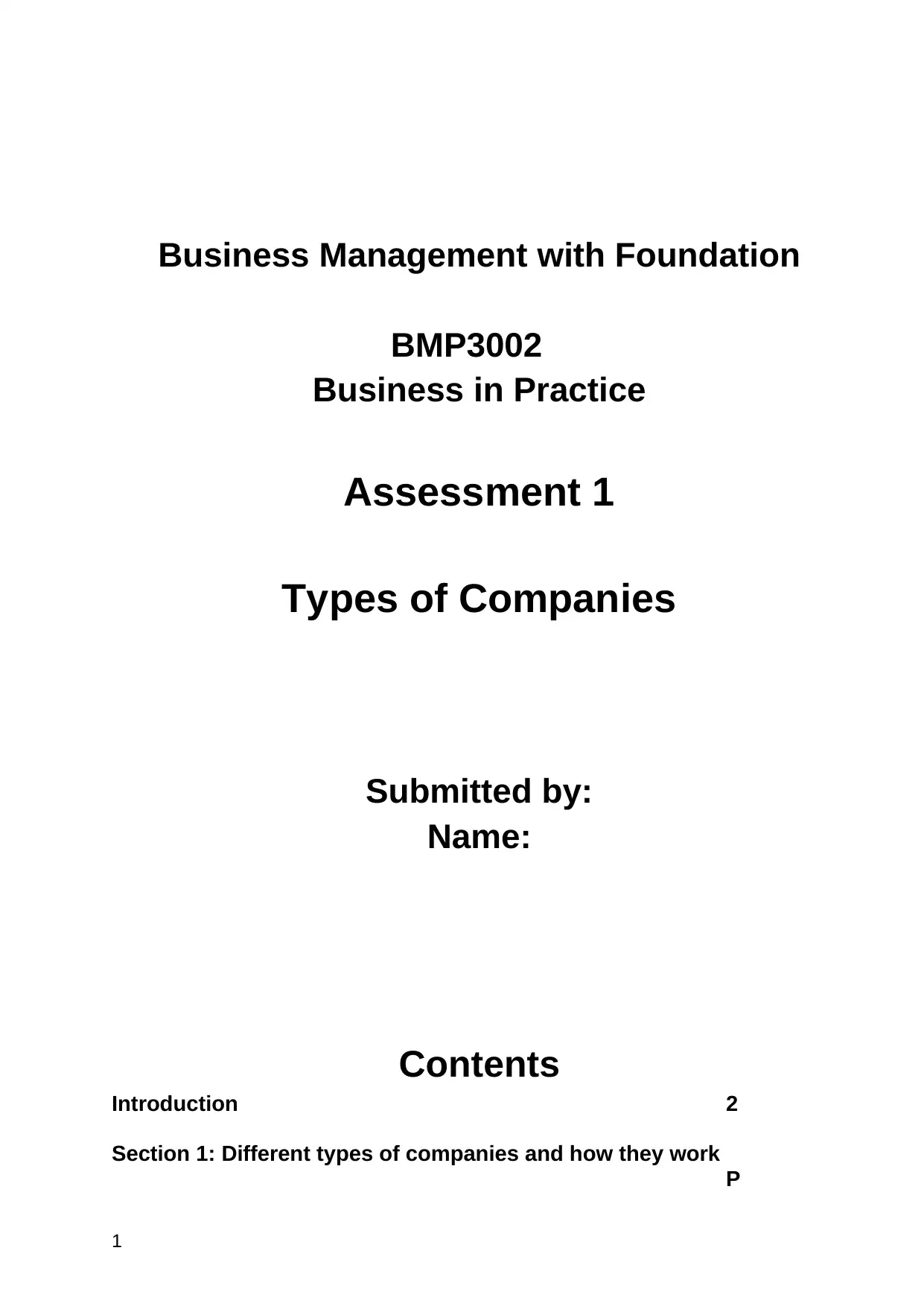
Business Management with Foundation
BMP3002
Business in Practice
Assessment 1
Types of Companies
Submitted by:
Name:
Contents
Introduction 2
Section 1: Different types of companies and how they work
P
1
BMP3002
Business in Practice
Assessment 1
Types of Companies
Submitted by:
Name:
Contents
Introduction 2
Section 1: Different types of companies and how they work
P
1
Paraphrase This Document
Need a fresh take? Get an instant paraphrase of this document with our AI Paraphraser
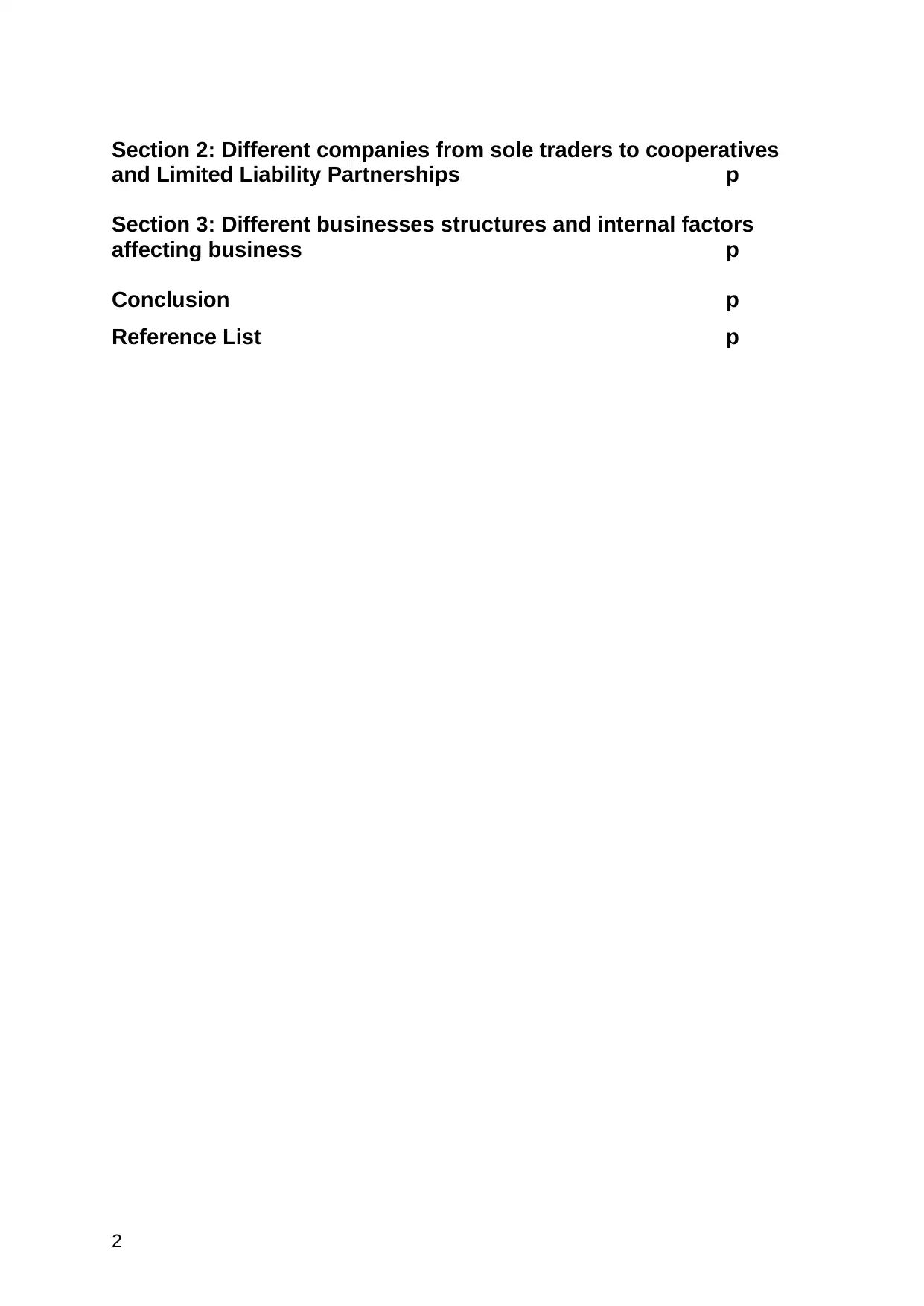
Section 2: Different companies from sole traders to cooperatives
and Limited Liability Partnerships p
Section 3: Different businesses structures and internal factors
affecting business p
Conclusion p
Reference List p
2
and Limited Liability Partnerships p
Section 3: Different businesses structures and internal factors
affecting business p
Conclusion p
Reference List p
2
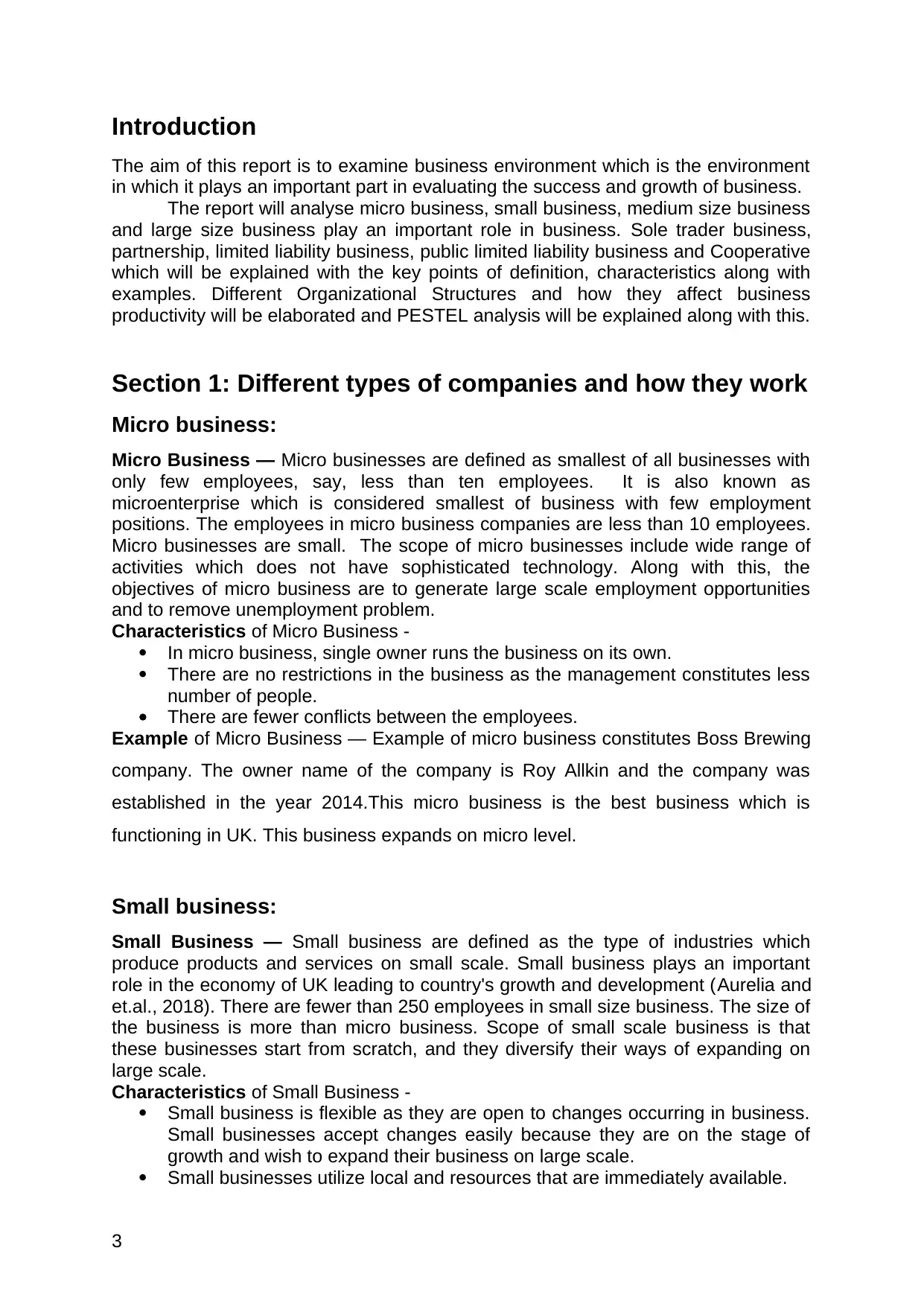
Introduction
The aim of this report is to examine business environment which is the environment
in which it plays an important part in evaluating the success and growth of business.
The report will analyse micro business, small business, medium size business
and large size business play an important role in business. Sole trader business,
partnership, limited liability business, public limited liability business and Cooperative
which will be explained with the key points of definition, characteristics along with
examples. Different Organizational Structures and how they affect business
productivity will be elaborated and PESTEL analysis will be explained along with this.
Section 1: Different types of companies and how they work
Micro business:
Micro Business — Micro businesses are defined as smallest of all businesses with
only few employees, say, less than ten employees. It is also known as
microenterprise which is considered smallest of business with few employment
positions. The employees in micro business companies are less than 10 employees.
Micro businesses are small. The scope of micro businesses include wide range of
activities which does not have sophisticated technology. Along with this, the
objectives of micro business are to generate large scale employment opportunities
and to remove unemployment problem.
Characteristics of Micro Business -
In micro business, single owner runs the business on its own.
There are no restrictions in the business as the management constitutes less
number of people.
There are fewer conflicts between the employees.
Example of Micro Business — Example of micro business constitutes Boss Brewing
company. The owner name of the company is Roy Allkin and the company was
established in the year 2014.This micro business is the best business which is
functioning in UK. This business expands on micro level.
Small business:
Small Business — Small business are defined as the type of industries which
produce products and services on small scale. Small business plays an important
role in the economy of UK leading to country's growth and development (Aurelia and
et.al., 2018). There are fewer than 250 employees in small size business. The size of
the business is more than micro business. Scope of small scale business is that
these businesses start from scratch, and they diversify their ways of expanding on
large scale.
Characteristics of Small Business -
Small business is flexible as they are open to changes occurring in business.
Small businesses accept changes easily because they are on the stage of
growth and wish to expand their business on large scale.
Small businesses utilize local and resources that are immediately available.
3
The aim of this report is to examine business environment which is the environment
in which it plays an important part in evaluating the success and growth of business.
The report will analyse micro business, small business, medium size business
and large size business play an important role in business. Sole trader business,
partnership, limited liability business, public limited liability business and Cooperative
which will be explained with the key points of definition, characteristics along with
examples. Different Organizational Structures and how they affect business
productivity will be elaborated and PESTEL analysis will be explained along with this.
Section 1: Different types of companies and how they work
Micro business:
Micro Business — Micro businesses are defined as smallest of all businesses with
only few employees, say, less than ten employees. It is also known as
microenterprise which is considered smallest of business with few employment
positions. The employees in micro business companies are less than 10 employees.
Micro businesses are small. The scope of micro businesses include wide range of
activities which does not have sophisticated technology. Along with this, the
objectives of micro business are to generate large scale employment opportunities
and to remove unemployment problem.
Characteristics of Micro Business -
In micro business, single owner runs the business on its own.
There are no restrictions in the business as the management constitutes less
number of people.
There are fewer conflicts between the employees.
Example of Micro Business — Example of micro business constitutes Boss Brewing
company. The owner name of the company is Roy Allkin and the company was
established in the year 2014.This micro business is the best business which is
functioning in UK. This business expands on micro level.
Small business:
Small Business — Small business are defined as the type of industries which
produce products and services on small scale. Small business plays an important
role in the economy of UK leading to country's growth and development (Aurelia and
et.al., 2018). There are fewer than 250 employees in small size business. The size of
the business is more than micro business. Scope of small scale business is that
these businesses start from scratch, and they diversify their ways of expanding on
large scale.
Characteristics of Small Business -
Small business is flexible as they are open to changes occurring in business.
Small businesses accept changes easily because they are on the stage of
growth and wish to expand their business on large scale.
Small businesses utilize local and resources that are immediately available.
3
⊘ This is a preview!⊘
Do you want full access?
Subscribe today to unlock all pages.

Trusted by 1+ million students worldwide
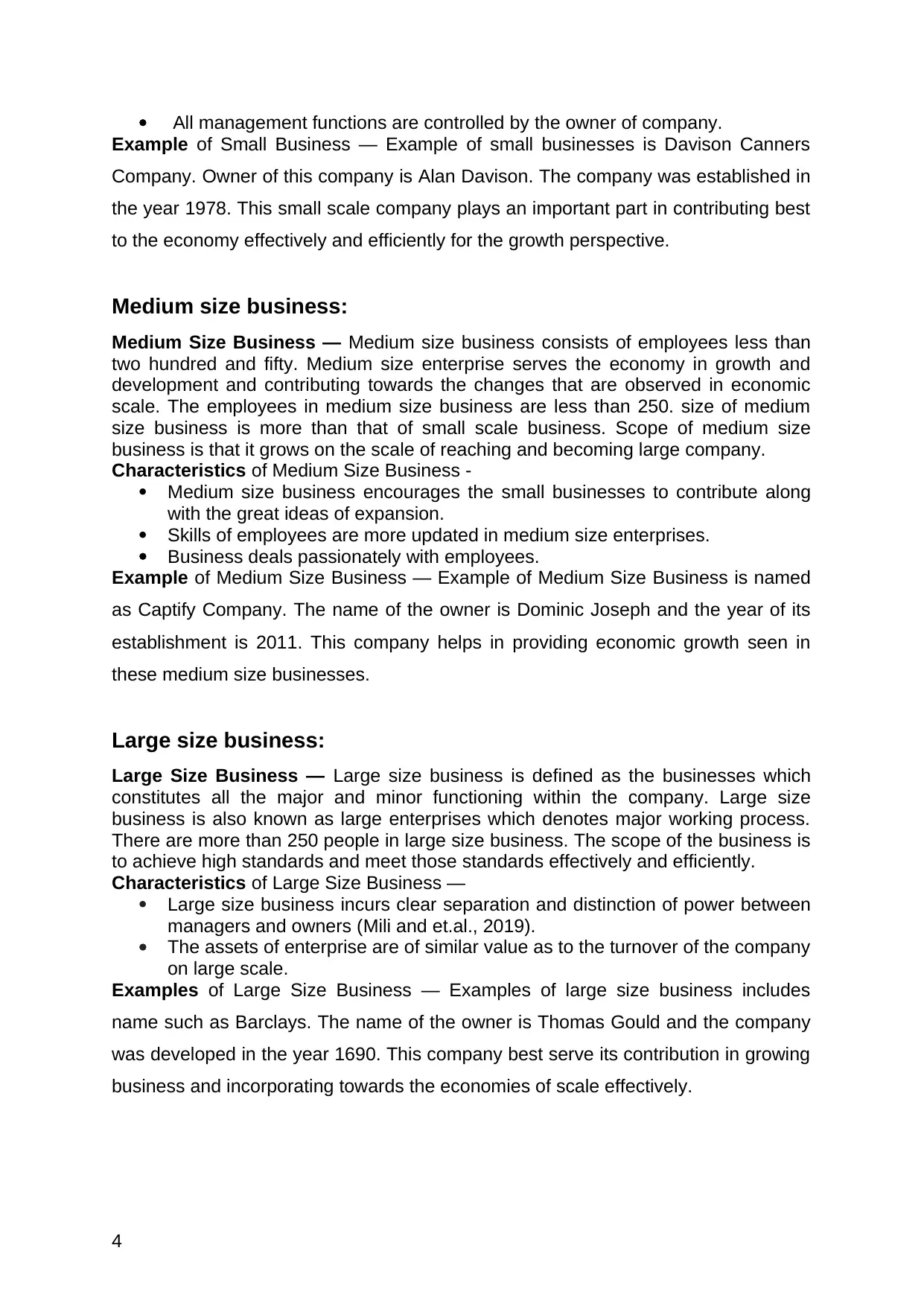
All management functions are controlled by the owner of company.
Example of Small Business — Example of small businesses is Davison Canners
Company. Owner of this company is Alan Davison. The company was established in
the year 1978. This small scale company plays an important part in contributing best
to the economy effectively and efficiently for the growth perspective.
Medium size business:
Medium Size Business — Medium size business consists of employees less than
two hundred and fifty. Medium size enterprise serves the economy in growth and
development and contributing towards the changes that are observed in economic
scale. The employees in medium size business are less than 250. size of medium
size business is more than that of small scale business. Scope of medium size
business is that it grows on the scale of reaching and becoming large company.
Characteristics of Medium Size Business -
Medium size business encourages the small businesses to contribute along
with the great ideas of expansion.
Skills of employees are more updated in medium size enterprises.
Business deals passionately with employees.
Example of Medium Size Business — Example of Medium Size Business is named
as Captify Company. The name of the owner is Dominic Joseph and the year of its
establishment is 2011. This company helps in providing economic growth seen in
these medium size businesses.
Large size business:
Large Size Business — Large size business is defined as the businesses which
constitutes all the major and minor functioning within the company. Large size
business is also known as large enterprises which denotes major working process.
There are more than 250 people in large size business. The scope of the business is
to achieve high standards and meet those standards effectively and efficiently.
Characteristics of Large Size Business —
Large size business incurs clear separation and distinction of power between
managers and owners (Mili and et.al., 2019).
The assets of enterprise are of similar value as to the turnover of the company
on large scale.
Examples of Large Size Business — Examples of large size business includes
name such as Barclays. The name of the owner is Thomas Gould and the company
was developed in the year 1690. This company best serve its contribution in growing
business and incorporating towards the economies of scale effectively.
4
Example of Small Business — Example of small businesses is Davison Canners
Company. Owner of this company is Alan Davison. The company was established in
the year 1978. This small scale company plays an important part in contributing best
to the economy effectively and efficiently for the growth perspective.
Medium size business:
Medium Size Business — Medium size business consists of employees less than
two hundred and fifty. Medium size enterprise serves the economy in growth and
development and contributing towards the changes that are observed in economic
scale. The employees in medium size business are less than 250. size of medium
size business is more than that of small scale business. Scope of medium size
business is that it grows on the scale of reaching and becoming large company.
Characteristics of Medium Size Business -
Medium size business encourages the small businesses to contribute along
with the great ideas of expansion.
Skills of employees are more updated in medium size enterprises.
Business deals passionately with employees.
Example of Medium Size Business — Example of Medium Size Business is named
as Captify Company. The name of the owner is Dominic Joseph and the year of its
establishment is 2011. This company helps in providing economic growth seen in
these medium size businesses.
Large size business:
Large Size Business — Large size business is defined as the businesses which
constitutes all the major and minor functioning within the company. Large size
business is also known as large enterprises which denotes major working process.
There are more than 250 people in large size business. The scope of the business is
to achieve high standards and meet those standards effectively and efficiently.
Characteristics of Large Size Business —
Large size business incurs clear separation and distinction of power between
managers and owners (Mili and et.al., 2019).
The assets of enterprise are of similar value as to the turnover of the company
on large scale.
Examples of Large Size Business — Examples of large size business includes
name such as Barclays. The name of the owner is Thomas Gould and the company
was developed in the year 1690. This company best serve its contribution in growing
business and incorporating towards the economies of scale effectively.
4
Paraphrase This Document
Need a fresh take? Get an instant paraphrase of this document with our AI Paraphraser
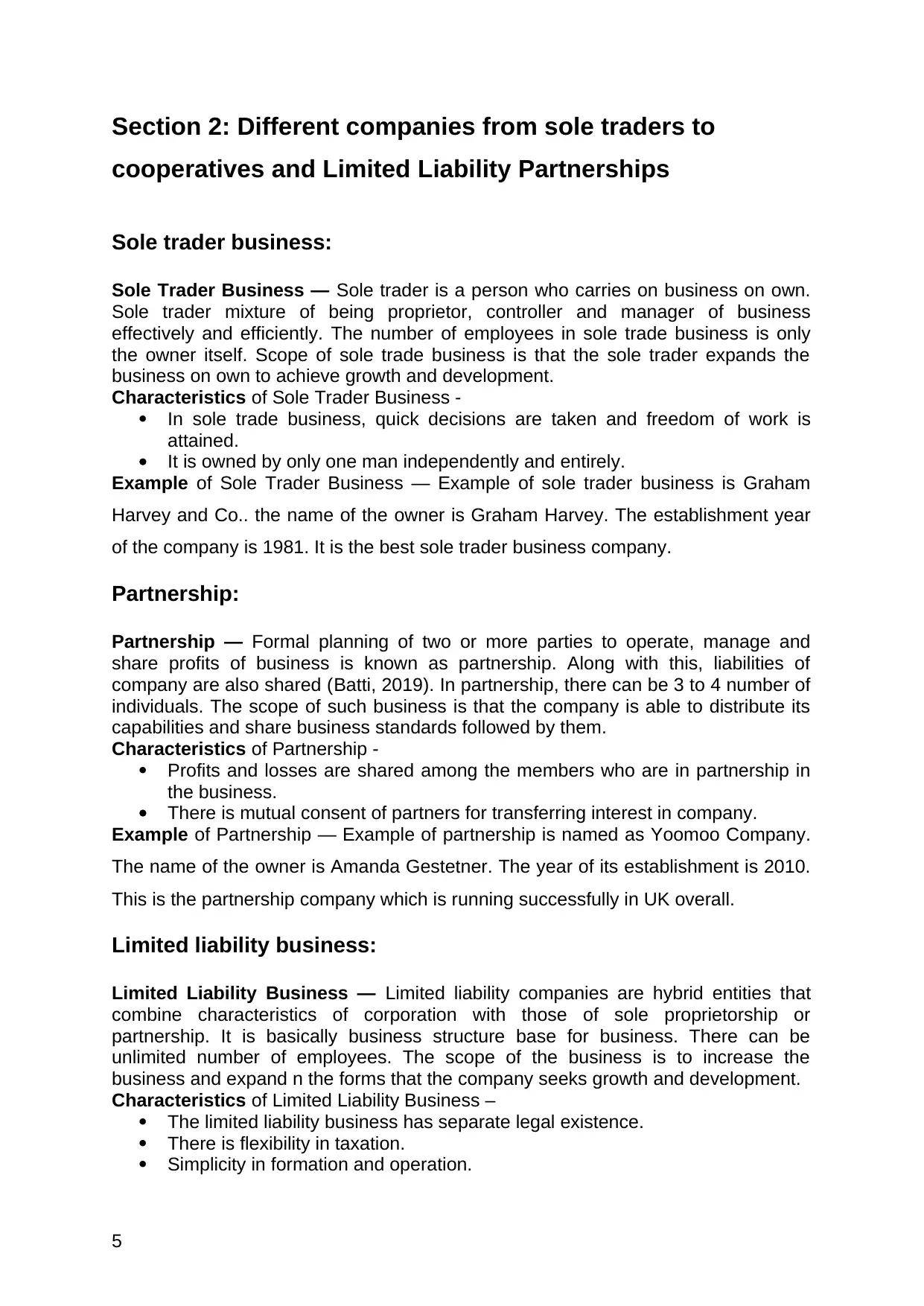
Section 2: Different companies from sole traders to
cooperatives and Limited Liability Partnerships
Sole trader business:
Sole Trader Business — Sole trader is a person who carries on business on own.
Sole trader mixture of being proprietor, controller and manager of business
effectively and efficiently. The number of employees in sole trade business is only
the owner itself. Scope of sole trade business is that the sole trader expands the
business on own to achieve growth and development.
Characteristics of Sole Trader Business -
In sole trade business, quick decisions are taken and freedom of work is
attained.
It is owned by only one man independently and entirely.
Example of Sole Trader Business — Example of sole trader business is Graham
Harvey and Co.. the name of the owner is Graham Harvey. The establishment year
of the company is 1981. It is the best sole trader business company.
Partnership:
Partnership — Formal planning of two or more parties to operate, manage and
share profits of business is known as partnership. Along with this, liabilities of
company are also shared (Batti, 2019). In partnership, there can be 3 to 4 number of
individuals. The scope of such business is that the company is able to distribute its
capabilities and share business standards followed by them.
Characteristics of Partnership -
Profits and losses are shared among the members who are in partnership in
the business.
There is mutual consent of partners for transferring interest in company.
Example of Partnership — Example of partnership is named as Yoomoo Company.
The name of the owner is Amanda Gestetner. The year of its establishment is 2010.
This is the partnership company which is running successfully in UK overall.
Limited liability business:
Limited Liability Business — Limited liability companies are hybrid entities that
combine characteristics of corporation with those of sole proprietorship or
partnership. It is basically business structure base for business. There can be
unlimited number of employees. The scope of the business is to increase the
business and expand n the forms that the company seeks growth and development.
Characteristics of Limited Liability Business –
The limited liability business has separate legal existence.
There is flexibility in taxation.
Simplicity in formation and operation.
5
cooperatives and Limited Liability Partnerships
Sole trader business:
Sole Trader Business — Sole trader is a person who carries on business on own.
Sole trader mixture of being proprietor, controller and manager of business
effectively and efficiently. The number of employees in sole trade business is only
the owner itself. Scope of sole trade business is that the sole trader expands the
business on own to achieve growth and development.
Characteristics of Sole Trader Business -
In sole trade business, quick decisions are taken and freedom of work is
attained.
It is owned by only one man independently and entirely.
Example of Sole Trader Business — Example of sole trader business is Graham
Harvey and Co.. the name of the owner is Graham Harvey. The establishment year
of the company is 1981. It is the best sole trader business company.
Partnership:
Partnership — Formal planning of two or more parties to operate, manage and
share profits of business is known as partnership. Along with this, liabilities of
company are also shared (Batti, 2019). In partnership, there can be 3 to 4 number of
individuals. The scope of such business is that the company is able to distribute its
capabilities and share business standards followed by them.
Characteristics of Partnership -
Profits and losses are shared among the members who are in partnership in
the business.
There is mutual consent of partners for transferring interest in company.
Example of Partnership — Example of partnership is named as Yoomoo Company.
The name of the owner is Amanda Gestetner. The year of its establishment is 2010.
This is the partnership company which is running successfully in UK overall.
Limited liability business:
Limited Liability Business — Limited liability companies are hybrid entities that
combine characteristics of corporation with those of sole proprietorship or
partnership. It is basically business structure base for business. There can be
unlimited number of employees. The scope of the business is to increase the
business and expand n the forms that the company seeks growth and development.
Characteristics of Limited Liability Business –
The limited liability business has separate legal existence.
There is flexibility in taxation.
Simplicity in formation and operation.
5
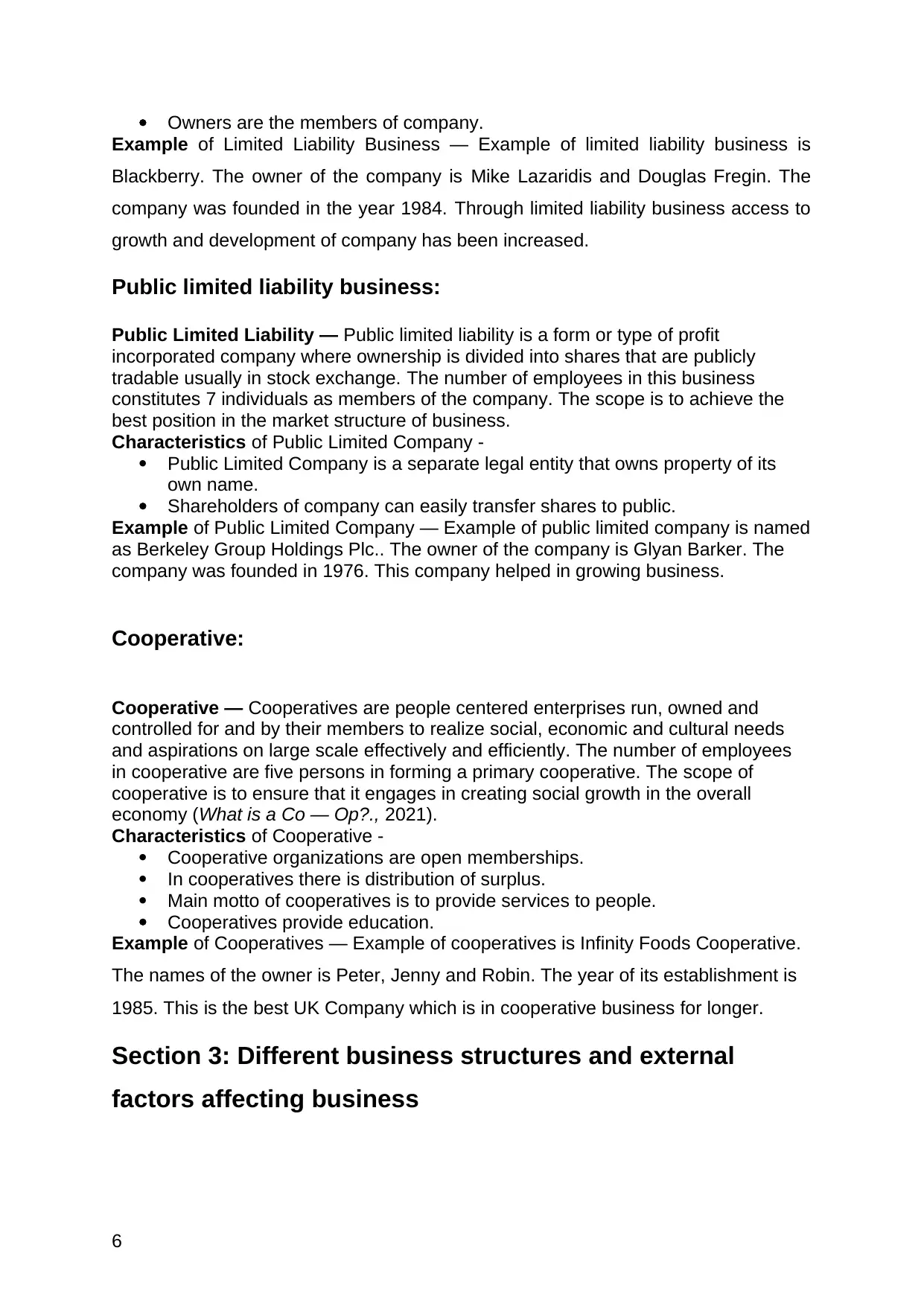
Owners are the members of company.
Example of Limited Liability Business — Example of limited liability business is
Blackberry. The owner of the company is Mike Lazaridis and Douglas Fregin. The
company was founded in the year 1984. Through limited liability business access to
growth and development of company has been increased.
Public limited liability business:
Public Limited Liability — Public limited liability is a form or type of profit
incorporated company where ownership is divided into shares that are publicly
tradable usually in stock exchange. The number of employees in this business
constitutes 7 individuals as members of the company. The scope is to achieve the
best position in the market structure of business.
Characteristics of Public Limited Company -
Public Limited Company is a separate legal entity that owns property of its
own name.
Shareholders of company can easily transfer shares to public.
Example of Public Limited Company — Example of public limited company is named
as Berkeley Group Holdings Plc.. The owner of the company is Glyan Barker. The
company was founded in 1976. This company helped in growing business.
Cooperative:
Cooperative — Cooperatives are people centered enterprises run, owned and
controlled for and by their members to realize social, economic and cultural needs
and aspirations on large scale effectively and efficiently. The number of employees
in cooperative are five persons in forming a primary cooperative. The scope of
cooperative is to ensure that it engages in creating social growth in the overall
economy (What is a Co — Op?., 2021).
Characteristics of Cooperative -
Cooperative organizations are open memberships.
In cooperatives there is distribution of surplus.
Main motto of cooperatives is to provide services to people.
Cooperatives provide education.
Example of Cooperatives — Example of cooperatives is Infinity Foods Cooperative.
The names of the owner is Peter, Jenny and Robin. The year of its establishment is
1985. This is the best UK Company which is in cooperative business for longer.
Section 3: Different business structures and external
factors affecting business
6
Example of Limited Liability Business — Example of limited liability business is
Blackberry. The owner of the company is Mike Lazaridis and Douglas Fregin. The
company was founded in the year 1984. Through limited liability business access to
growth and development of company has been increased.
Public limited liability business:
Public Limited Liability — Public limited liability is a form or type of profit
incorporated company where ownership is divided into shares that are publicly
tradable usually in stock exchange. The number of employees in this business
constitutes 7 individuals as members of the company. The scope is to achieve the
best position in the market structure of business.
Characteristics of Public Limited Company -
Public Limited Company is a separate legal entity that owns property of its
own name.
Shareholders of company can easily transfer shares to public.
Example of Public Limited Company — Example of public limited company is named
as Berkeley Group Holdings Plc.. The owner of the company is Glyan Barker. The
company was founded in 1976. This company helped in growing business.
Cooperative:
Cooperative — Cooperatives are people centered enterprises run, owned and
controlled for and by their members to realize social, economic and cultural needs
and aspirations on large scale effectively and efficiently. The number of employees
in cooperative are five persons in forming a primary cooperative. The scope of
cooperative is to ensure that it engages in creating social growth in the overall
economy (What is a Co — Op?., 2021).
Characteristics of Cooperative -
Cooperative organizations are open memberships.
In cooperatives there is distribution of surplus.
Main motto of cooperatives is to provide services to people.
Cooperatives provide education.
Example of Cooperatives — Example of cooperatives is Infinity Foods Cooperative.
The names of the owner is Peter, Jenny and Robin. The year of its establishment is
1985. This is the best UK Company which is in cooperative business for longer.
Section 3: Different business structures and external
factors affecting business
6
⊘ This is a preview!⊘
Do you want full access?
Subscribe today to unlock all pages.

Trusted by 1+ million students worldwide
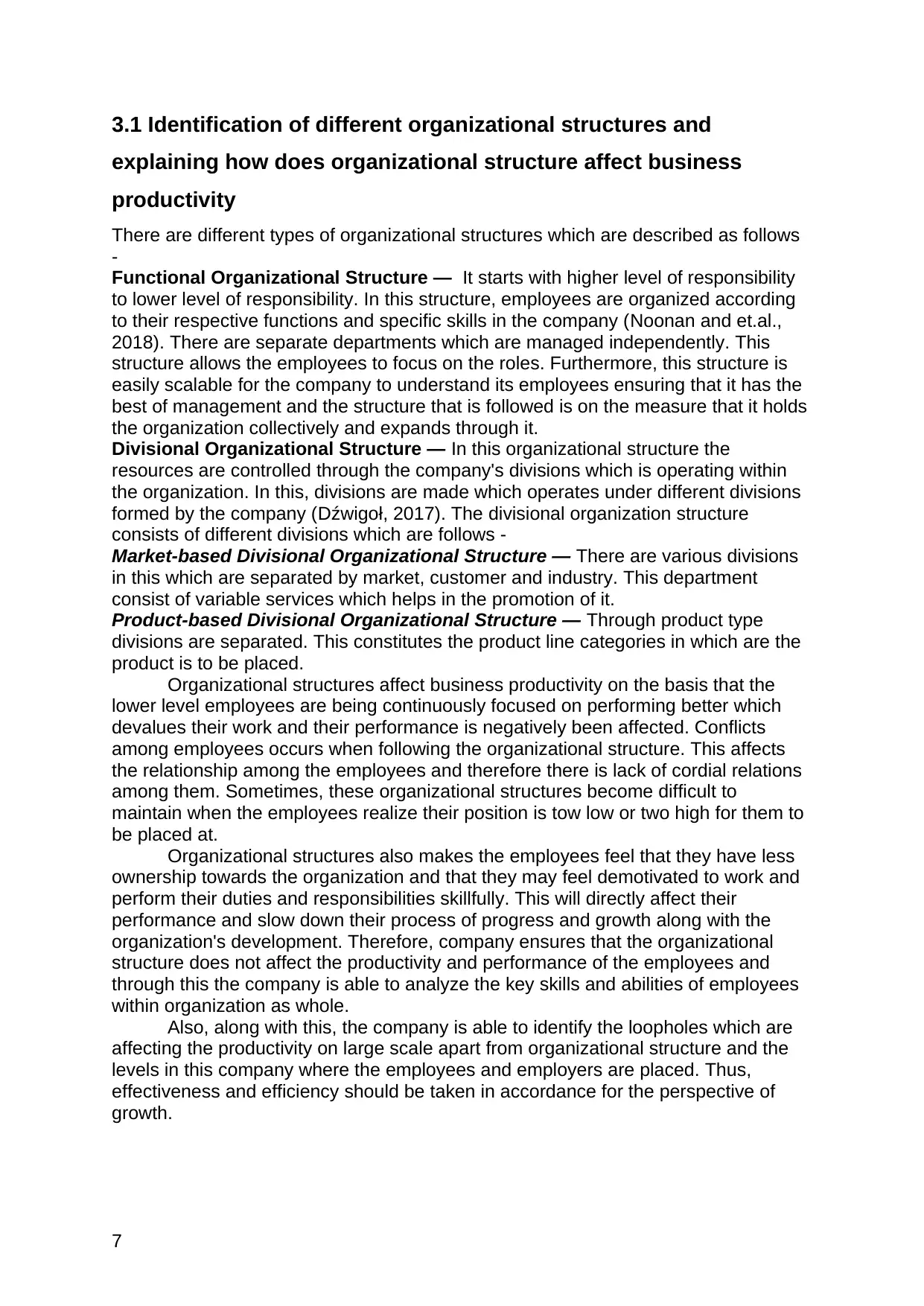
3.1 Identification of different organizational structures and
explaining how does organizational structure affect business
productivity
There are different types of organizational structures which are described as follows
-
Functional Organizational Structure — It starts with higher level of responsibility
to lower level of responsibility. In this structure, employees are organized according
to their respective functions and specific skills in the company (Noonan and et.al.,
2018). There are separate departments which are managed independently. This
structure allows the employees to focus on the roles. Furthermore, this structure is
easily scalable for the company to understand its employees ensuring that it has the
best of management and the structure that is followed is on the measure that it holds
the organization collectively and expands through it.
Divisional Organizational Structure — In this organizational structure the
resources are controlled through the company's divisions which is operating within
the organization. In this, divisions are made which operates under different divisions
formed by the company (Dźwigoł, 2017). The divisional organization structure
consists of different divisions which are follows -
Market-based Divisional Organizational Structure — There are various divisions
in this which are separated by market, customer and industry. This department
consist of variable services which helps in the promotion of it.
Product-based Divisional Organizational Structure — Through product type
divisions are separated. This constitutes the product line categories in which are the
product is to be placed.
Organizational structures affect business productivity on the basis that the
lower level employees are being continuously focused on performing better which
devalues their work and their performance is negatively been affected. Conflicts
among employees occurs when following the organizational structure. This affects
the relationship among the employees and therefore there is lack of cordial relations
among them. Sometimes, these organizational structures become difficult to
maintain when the employees realize their position is tow low or two high for them to
be placed at.
Organizational structures also makes the employees feel that they have less
ownership towards the organization and that they may feel demotivated to work and
perform their duties and responsibilities skillfully. This will directly affect their
performance and slow down their process of progress and growth along with the
organization's development. Therefore, company ensures that the organizational
structure does not affect the productivity and performance of the employees and
through this the company is able to analyze the key skills and abilities of employees
within organization as whole.
Also, along with this, the company is able to identify the loopholes which are
affecting the productivity on large scale apart from organizational structure and the
levels in this company where the employees and employers are placed. Thus,
effectiveness and efficiency should be taken in accordance for the perspective of
growth.
7
explaining how does organizational structure affect business
productivity
There are different types of organizational structures which are described as follows
-
Functional Organizational Structure — It starts with higher level of responsibility
to lower level of responsibility. In this structure, employees are organized according
to their respective functions and specific skills in the company (Noonan and et.al.,
2018). There are separate departments which are managed independently. This
structure allows the employees to focus on the roles. Furthermore, this structure is
easily scalable for the company to understand its employees ensuring that it has the
best of management and the structure that is followed is on the measure that it holds
the organization collectively and expands through it.
Divisional Organizational Structure — In this organizational structure the
resources are controlled through the company's divisions which is operating within
the organization. In this, divisions are made which operates under different divisions
formed by the company (Dźwigoł, 2017). The divisional organization structure
consists of different divisions which are follows -
Market-based Divisional Organizational Structure — There are various divisions
in this which are separated by market, customer and industry. This department
consist of variable services which helps in the promotion of it.
Product-based Divisional Organizational Structure — Through product type
divisions are separated. This constitutes the product line categories in which are the
product is to be placed.
Organizational structures affect business productivity on the basis that the
lower level employees are being continuously focused on performing better which
devalues their work and their performance is negatively been affected. Conflicts
among employees occurs when following the organizational structure. This affects
the relationship among the employees and therefore there is lack of cordial relations
among them. Sometimes, these organizational structures become difficult to
maintain when the employees realize their position is tow low or two high for them to
be placed at.
Organizational structures also makes the employees feel that they have less
ownership towards the organization and that they may feel demotivated to work and
perform their duties and responsibilities skillfully. This will directly affect their
performance and slow down their process of progress and growth along with the
organization's development. Therefore, company ensures that the organizational
structure does not affect the productivity and performance of the employees and
through this the company is able to analyze the key skills and abilities of employees
within organization as whole.
Also, along with this, the company is able to identify the loopholes which are
affecting the productivity on large scale apart from organizational structure and the
levels in this company where the employees and employers are placed. Thus,
effectiveness and efficiency should be taken in accordance for the perspective of
growth.
7
Paraphrase This Document
Need a fresh take? Get an instant paraphrase of this document with our AI Paraphraser
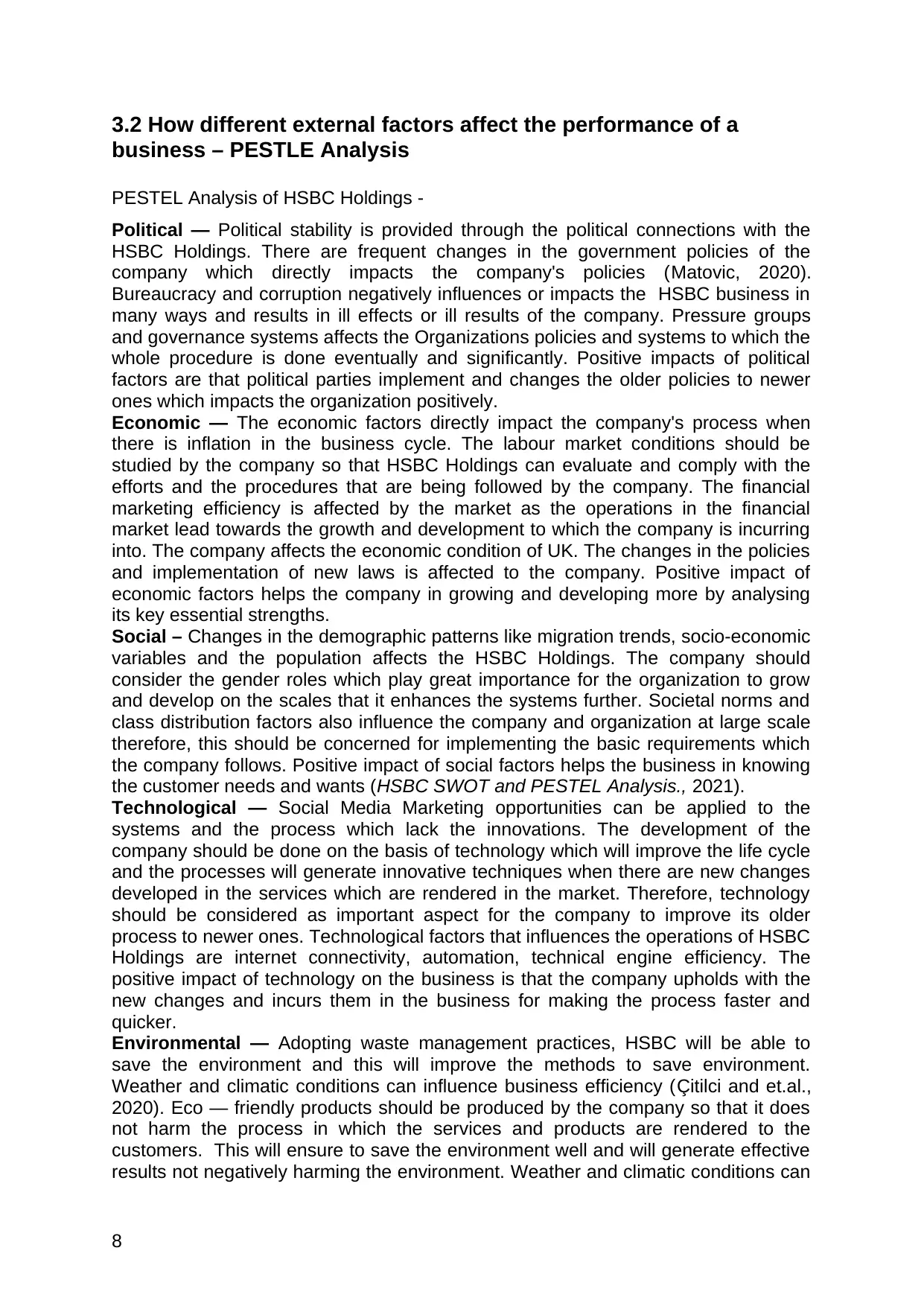
3.2 How different external factors affect the performance of a
business – PESTLE Analysis
PESTEL Analysis of HSBC Holdings -
Political — Political stability is provided through the political connections with the
HSBC Holdings. There are frequent changes in the government policies of the
company which directly impacts the company's policies (Matovic, 2020).
Bureaucracy and corruption negatively influences or impacts the HSBC business in
many ways and results in ill effects or ill results of the company. Pressure groups
and governance systems affects the Organizations policies and systems to which the
whole procedure is done eventually and significantly. Positive impacts of political
factors are that political parties implement and changes the older policies to newer
ones which impacts the organization positively.
Economic — The economic factors directly impact the company's process when
there is inflation in the business cycle. The labour market conditions should be
studied by the company so that HSBC Holdings can evaluate and comply with the
efforts and the procedures that are being followed by the company. The financial
marketing efficiency is affected by the market as the operations in the financial
market lead towards the growth and development to which the company is incurring
into. The company affects the economic condition of UK. The changes in the policies
and implementation of new laws is affected to the company. Positive impact of
economic factors helps the company in growing and developing more by analysing
its key essential strengths.
Social – Changes in the demographic patterns like migration trends, socio-economic
variables and the population affects the HSBC Holdings. The company should
consider the gender roles which play great importance for the organization to grow
and develop on the scales that it enhances the systems further. Societal norms and
class distribution factors also influence the company and organization at large scale
therefore, this should be concerned for implementing the basic requirements which
the company follows. Positive impact of social factors helps the business in knowing
the customer needs and wants (HSBC SWOT and PESTEL Analysis., 2021).
Technological — Social Media Marketing opportunities can be applied to the
systems and the process which lack the innovations. The development of the
company should be done on the basis of technology which will improve the life cycle
and the processes will generate innovative techniques when there are new changes
developed in the services which are rendered in the market. Therefore, technology
should be considered as important aspect for the company to improve its older
process to newer ones. Technological factors that influences the operations of HSBC
Holdings are internet connectivity, automation, technical engine efficiency. The
positive impact of technology on the business is that the company upholds with the
new changes and incurs them in the business for making the process faster and
quicker.
Environmental — Adopting waste management practices, HSBC will be able to
save the environment and this will improve the methods to save environment.
Weather and climatic conditions can influence business efficiency (Çitilci and et.al.,
2020). Eco — friendly products should be produced by the company so that it does
not harm the process in which the services and products are rendered to the
customers. This will ensure to save the environment well and will generate effective
results not negatively harming the environment. Weather and climatic conditions can
8
business – PESTLE Analysis
PESTEL Analysis of HSBC Holdings -
Political — Political stability is provided through the political connections with the
HSBC Holdings. There are frequent changes in the government policies of the
company which directly impacts the company's policies (Matovic, 2020).
Bureaucracy and corruption negatively influences or impacts the HSBC business in
many ways and results in ill effects or ill results of the company. Pressure groups
and governance systems affects the Organizations policies and systems to which the
whole procedure is done eventually and significantly. Positive impacts of political
factors are that political parties implement and changes the older policies to newer
ones which impacts the organization positively.
Economic — The economic factors directly impact the company's process when
there is inflation in the business cycle. The labour market conditions should be
studied by the company so that HSBC Holdings can evaluate and comply with the
efforts and the procedures that are being followed by the company. The financial
marketing efficiency is affected by the market as the operations in the financial
market lead towards the growth and development to which the company is incurring
into. The company affects the economic condition of UK. The changes in the policies
and implementation of new laws is affected to the company. Positive impact of
economic factors helps the company in growing and developing more by analysing
its key essential strengths.
Social – Changes in the demographic patterns like migration trends, socio-economic
variables and the population affects the HSBC Holdings. The company should
consider the gender roles which play great importance for the organization to grow
and develop on the scales that it enhances the systems further. Societal norms and
class distribution factors also influence the company and organization at large scale
therefore, this should be concerned for implementing the basic requirements which
the company follows. Positive impact of social factors helps the business in knowing
the customer needs and wants (HSBC SWOT and PESTEL Analysis., 2021).
Technological — Social Media Marketing opportunities can be applied to the
systems and the process which lack the innovations. The development of the
company should be done on the basis of technology which will improve the life cycle
and the processes will generate innovative techniques when there are new changes
developed in the services which are rendered in the market. Therefore, technology
should be considered as important aspect for the company to improve its older
process to newer ones. Technological factors that influences the operations of HSBC
Holdings are internet connectivity, automation, technical engine efficiency. The
positive impact of technology on the business is that the company upholds with the
new changes and incurs them in the business for making the process faster and
quicker.
Environmental — Adopting waste management practices, HSBC will be able to
save the environment and this will improve the methods to save environment.
Weather and climatic conditions can influence business efficiency (Çitilci and et.al.,
2020). Eco — friendly products should be produced by the company so that it does
not harm the process in which the services and products are rendered to the
customers. This will ensure to save the environment well and will generate effective
results not negatively harming the environment. Weather and climatic conditions can
8
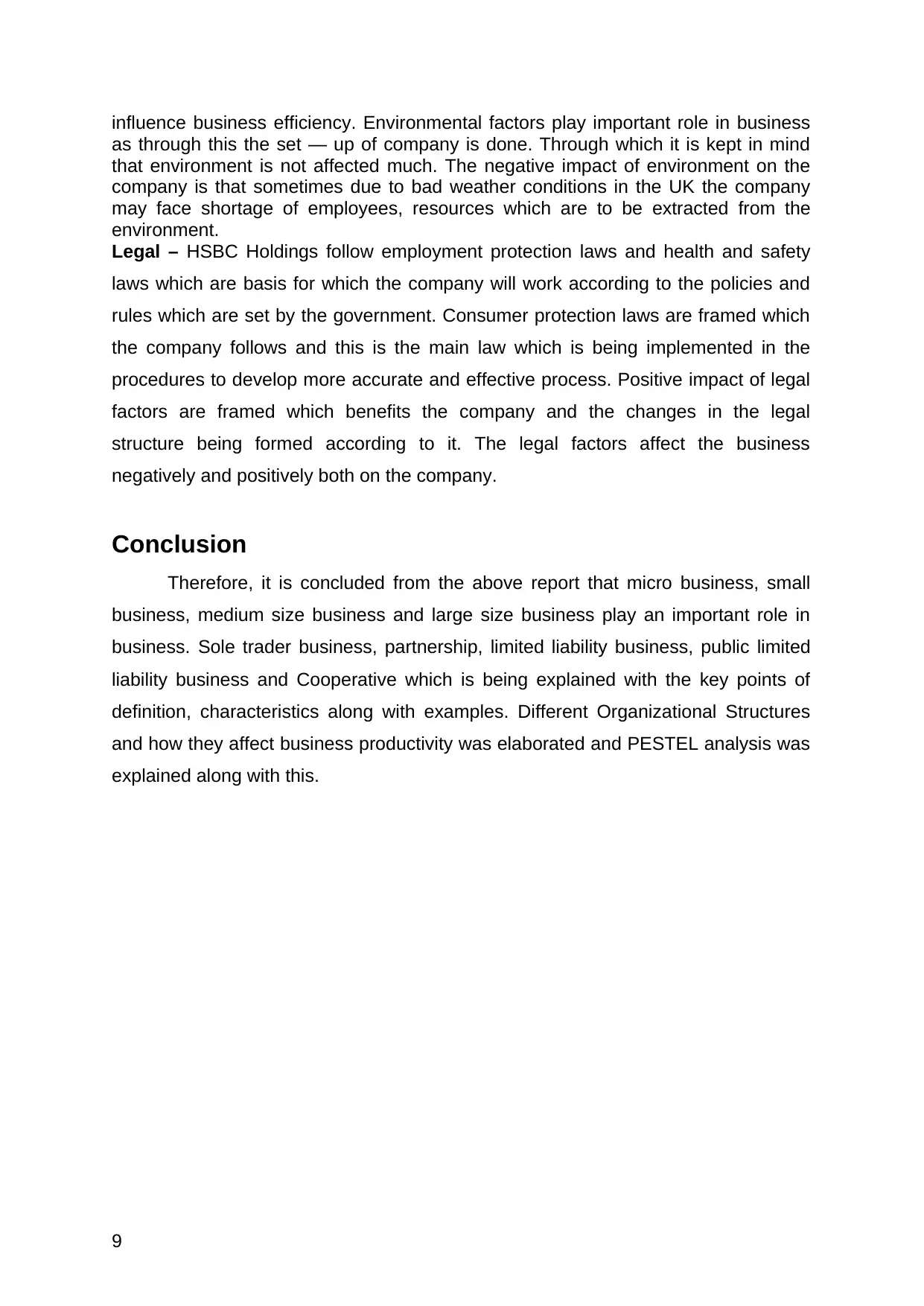
influence business efficiency. Environmental factors play important role in business
as through this the set — up of company is done. Through which it is kept in mind
that environment is not affected much. The negative impact of environment on the
company is that sometimes due to bad weather conditions in the UK the company
may face shortage of employees, resources which are to be extracted from the
environment.
Legal – HSBC Holdings follow employment protection laws and health and safety
laws which are basis for which the company will work according to the policies and
rules which are set by the government. Consumer protection laws are framed which
the company follows and this is the main law which is being implemented in the
procedures to develop more accurate and effective process. Positive impact of legal
factors are framed which benefits the company and the changes in the legal
structure being formed according to it. The legal factors affect the business
negatively and positively both on the company.
Conclusion
Therefore, it is concluded from the above report that micro business, small
business, medium size business and large size business play an important role in
business. Sole trader business, partnership, limited liability business, public limited
liability business and Cooperative which is being explained with the key points of
definition, characteristics along with examples. Different Organizational Structures
and how they affect business productivity was elaborated and PESTEL analysis was
explained along with this.
9
as through this the set — up of company is done. Through which it is kept in mind
that environment is not affected much. The negative impact of environment on the
company is that sometimes due to bad weather conditions in the UK the company
may face shortage of employees, resources which are to be extracted from the
environment.
Legal – HSBC Holdings follow employment protection laws and health and safety
laws which are basis for which the company will work according to the policies and
rules which are set by the government. Consumer protection laws are framed which
the company follows and this is the main law which is being implemented in the
procedures to develop more accurate and effective process. Positive impact of legal
factors are framed which benefits the company and the changes in the legal
structure being formed according to it. The legal factors affect the business
negatively and positively both on the company.
Conclusion
Therefore, it is concluded from the above report that micro business, small
business, medium size business and large size business play an important role in
business. Sole trader business, partnership, limited liability business, public limited
liability business and Cooperative which is being explained with the key points of
definition, characteristics along with examples. Different Organizational Structures
and how they affect business productivity was elaborated and PESTEL analysis was
explained along with this.
9
⊘ This is a preview!⊘
Do you want full access?
Subscribe today to unlock all pages.

Trusted by 1+ million students worldwide
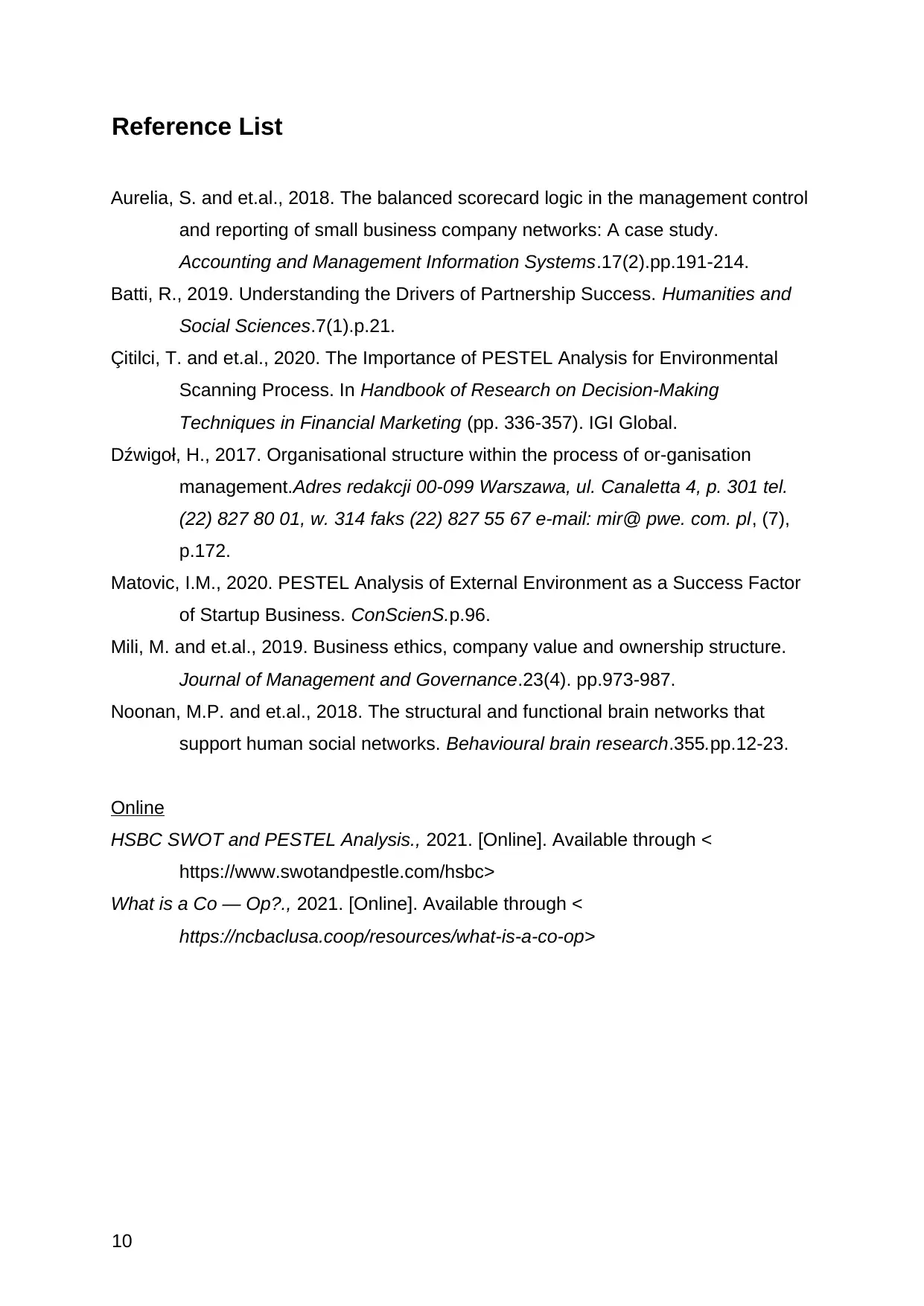
Reference List
Aurelia, S. and et.al., 2018. The balanced scorecard logic in the management control
and reporting of small business company networks: A case study.
Accounting and Management Information Systems.17(2).pp.191-214.
Batti, R., 2019. Understanding the Drivers of Partnership Success. Humanities and
Social Sciences.7(1).p.21.
Çitilci, T. and et.al., 2020. The Importance of PESTEL Analysis for Environmental
Scanning Process. In Handbook of Research on Decision-Making
Techniques in Financial Marketing (pp. 336-357). IGI Global.
Dźwigoł, H., 2017. Organisational structure within the process of or-ganisation
management.Adres redakcji 00-099 Warszawa, ul. Canaletta 4, p. 301 tel.
(22) 827 80 01, w. 314 faks (22) 827 55 67 e-mail: mir@ pwe. com. pl, (7),
p.172.
Matovic, I.M., 2020. PESTEL Analysis of External Environment as a Success Factor
of Startup Business. ConScienS.p.96.
Mili, M. and et.al., 2019. Business ethics, company value and ownership structure.
Journal of Management and Governance.23(4). pp.973-987.
Noonan, M.P. and et.al., 2018. The structural and functional brain networks that
support human social networks. Behavioural brain research.355.pp.12-23.
Online
HSBC SWOT and PESTEL Analysis., 2021. [Online]. Available through <
https://www.swotandpestle.com/hsbc>
What is a Co — Op?., 2021. [Online]. Available through <
https://ncbaclusa.coop/resources/what-is-a-co-op>
10
Aurelia, S. and et.al., 2018. The balanced scorecard logic in the management control
and reporting of small business company networks: A case study.
Accounting and Management Information Systems.17(2).pp.191-214.
Batti, R., 2019. Understanding the Drivers of Partnership Success. Humanities and
Social Sciences.7(1).p.21.
Çitilci, T. and et.al., 2020. The Importance of PESTEL Analysis for Environmental
Scanning Process. In Handbook of Research on Decision-Making
Techniques in Financial Marketing (pp. 336-357). IGI Global.
Dźwigoł, H., 2017. Organisational structure within the process of or-ganisation
management.Adres redakcji 00-099 Warszawa, ul. Canaletta 4, p. 301 tel.
(22) 827 80 01, w. 314 faks (22) 827 55 67 e-mail: mir@ pwe. com. pl, (7),
p.172.
Matovic, I.M., 2020. PESTEL Analysis of External Environment as a Success Factor
of Startup Business. ConScienS.p.96.
Mili, M. and et.al., 2019. Business ethics, company value and ownership structure.
Journal of Management and Governance.23(4). pp.973-987.
Noonan, M.P. and et.al., 2018. The structural and functional brain networks that
support human social networks. Behavioural brain research.355.pp.12-23.
Online
HSBC SWOT and PESTEL Analysis., 2021. [Online]. Available through <
https://www.swotandpestle.com/hsbc>
What is a Co — Op?., 2021. [Online]. Available through <
https://ncbaclusa.coop/resources/what-is-a-co-op>
10
1 out of 10
Related Documents
Your All-in-One AI-Powered Toolkit for Academic Success.
+13062052269
info@desklib.com
Available 24*7 on WhatsApp / Email
![[object Object]](/_next/static/media/star-bottom.7253800d.svg)
Unlock your academic potential
Copyright © 2020–2025 A2Z Services. All Rights Reserved. Developed and managed by ZUCOL.



